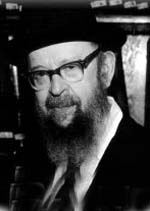News
This site is not another political blog interested in stating its author's opinions on the latest house vote and presidential address. But, I do wish to discuss some news organizations that are more traditional in nature for the political junky amongst us.
As sourced on the site previously, JewishWorldReview.com is a source of many editorialists and columnists mixed in with Torah articles. Another site is from the Shema Yisrael Torah Network called Dei'ah veDibur (which has a connection to the print Yated see http://chareidi.shemayisrael.com/akenesststld67.htm). It is published weekly. For other news sources, see later.
Here are two article from Dei'ah veDibur:
Thousands Join Gedolei Yisroel for Gathering to Strengthen Modesty
By Betzalel Kahn
Original Link: http://chareidi.shemayisrael.com/akenesststld67.htm
CBS: Children Make Up One-Third of Israel's Population
By G. Kleiman
Original Link: http://chareidi.shemayisrael.com/TLD67ademog.htm
DQB
B'Soch Ha'Emek thought of the day: Study Torah :)
As sourced on the site previously, JewishWorldReview.com is a source of many editorialists and columnists mixed in with Torah articles. Another site is from the Shema Yisrael Torah Network called Dei'ah veDibur (which has a connection to the print Yated see http://chareidi.shemayisrael.com/akenesststld67.htm). It is published weekly. For other news sources, see later.
Here are two article from Dei'ah veDibur:
Thousands Join Gedolei Yisroel for Gathering to Strengthen Modesty
By Betzalel Kahn
A major gathering on Motzei Shabbos at Ramat Tamir Halls in Jerusalem was attended by a number of gedolei Yisroel led by Maran HaRav Eliashiv shlita, roshei yeshivos, roshei kollelim and thousands of avreichim.
Speeches were given by HaRav Dovid Cohen, rosh yeshiva of Yeshivas Chevron, HaRav Shmuel Betzalel, one of the roshei yeshiva of Yeshivat Porat Yosef, HaRav Michel Yehuda Lefkowitz, HaRav Aharon Yehuda Leib Shteinman, HaRav Boruch Shapira and HaRav Aviezer Piltz, rosh yeshiva of Yeshivas Tifrach.
HaRav Lefkowitz said Torah cannot be sustained in a home where standards of modesty are inadequate. "If modesty is lacking at home, chas vesholom, can the mother inculcate Torah values in her children? As she prepares to recite the blessings over the candles on Erev Shabbos, a fitting time to pray that her sons grow up to be talmidei chachomim and yirei Shomayim, can her prayers be accepted if she is dressed in immodest clothes? In honor of Shabbos one should wear nice, modest clothes. But is it possible to make requests of HaKodosh Boruch Hu regarding one's sons and daughter dressed in today's fashions?"
Speaking briefly, HaRav Shteinman endorsed the remarks of the rabbonim who had spoken earlier and also cited the verse, "Velo yeiro'eh becho ervas dovor," saying that if women are not properly covered the Divine Presence will not be in our midst. "At least the bit of Divine Presence we have, we should try not to lose," he said.
The final wording of the practical recommendations of the kenes was not available at press time, and the Vaada Ruchanit said that we should not publish a draft on something this sensitive.
Original Link: http://chareidi.shemayisrael.com/akenesststld67.htm
CBS: Children Make Up One-Third of Israel's Population
By G. Kleiman
Central Bureau of Statistics (CBS) figures show that at the end of 2005 there were 2,326,400 children (ages 0-17) living in Israel: 1,608,300 Jewish children, 643,000 Arab children and more than 70,000 "other" children from immigrant families whose religion is not listed in the population registry.
Like in 2004, children constitute one-third of the total population. In most of the Western world the percentage of children is considerably smaller, whereas in many Arab countries children constitute half of the population.
In 2005 there were 143,900 babies born, of which 51.4 percent were boys. 100,700 were born to Jewish mothers, 34,200 to Muslim mothers, 4,000 to mothers whose religion is not listed, 2,500 to Druse mothers and 2,500 to Christian mothers.
The highest child-adult ratio of any municipality is in Beitar Illit, where children constitute 63 percent of the population. In Modi'in Illit and Elad as well, the percentage of children is approaching the 60 percent mark. Similar figures were recorded in Bedouin towns in the South, such as Tel Sheva, Rahat and Kasifa.
As in past years Jerusalem has the largest child population in absolute numbers, with 291,700 children representing 40.5 percent of city residents. Tel Aviv-Jaffa is second with 75,400 children, but there they represent a mere 20 percent of the overall population — the lowest child-adult ratio of any urban center in Israel. In Givatayim, Bat Yam and Ramat Gan as well, the ratio hovers around the 20 percent mark.
In contrast Bnei Brak's 67,500 children constitute 47 percent of the population. In Modi'in-Maccabim and Re'ut, both of which have a large concentration of (non-chareidi) young couples, the portion of children is 43 percent and 41 percent respectively.
Of the 574,468 children enrolled in Jewish sector primary schools in 5765, 25 percent studied at chareidi schools (up from 21.9 percent in 5763) compared to 56 percent at government schools (down from 59 percent in 5763) and 18.9 percent at government-religious schools (down from 19.1 percent in 5763).
Original Link: http://chareidi.shemayisrael.com/TLD67ademog.htm
DQB
B'Soch Ha'Emek thought of the day: Study Torah :)


0 Comments:
Post a Comment
<< Home